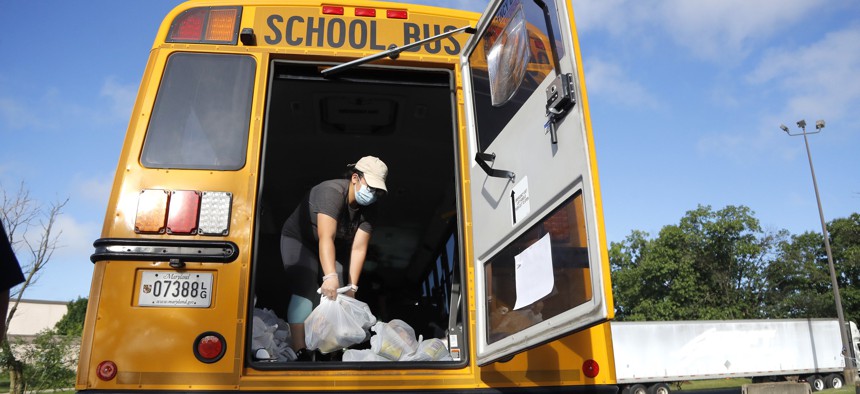Local Governments Add Some Jobs in August, But State and Local Payrolls Still Way Down

A bus driver with the Montgomery County School District helps load a bus with bags of food to be donated to residents, Friday, July 10, 2020, in Derwood, Md. AP Photo/Julio Cortez

Connecting state and local government leaders
State and local governments have about 1 million fewer employees than they did a year ago.
Local governments added 95,000 jobs in August and state employment remained relatively flat, as the coronavirus continued to strain public budgets, according to figures the Labor Department released Friday.
Despite the improvement, there were still about 1 million fewer workers on state and local government payrolls in August compared to a year earlier.
The U.S. economy more broadly added 1.4 million jobs in August, and the unemployment rate fell to 8.4% from 10.2% in July, the latest Labor Department statistics show. The employment gains were weaker than the 1.7 million jobs added in July, or the 4.8 million posted in June.
Now about six months into the pandemic, the U.S. has roughly 11.5 million fewer jobs than it did in February, before the virus upended the economy.
About 31,000 of the local government jobs added in August, were in education-related positions. The rise in local government employment outside of education—63,000 jobs—was the strongest since employment in the sector plummeted in April.
Overall local governments had an estimated 13.7 million employees in August, compared to nearly 14.6 million last August.
At the state level, non-education employment ticked up slightly by an estimated 2,000 jobs, while state jobs tied to education fell by 3,900, for a net loss of about 2,000 jobs. State employment totaled about 4.9 million, compared to about 5.1 million a year earlier.
States and localities have resorted to a mix of layoffs, furloughs and hiring freezes as the coronavirus outbreak has put a historic drag on economic activity and tax revenues, while also driving unplanned government spending on the response to the public health crisis.
Economists and state and local leaders have warned that widespread and lasting public sector layoffs at the state and local level could hamper the nation’s economic recovery.
“As in the Great Recession, the pursuit of austerity will stifle a quick and full recovery,” Elise Gould, an economist with the left-leaning Economic Policy Institute wrote on Friday.
Gould added that schools around the country are likely in need of more, not less, staff in the coming months, as they try to reopen with the added challenges posed by the coronavirus.
She also suggested the federal government could boost public employment through hiring more public health workers and contact tracers—the workers who track down and follow up with people who’ve come in close contact with someone found to have the virus.
Democrats and Republicans in Congress are at odds over whether to provide states and localities with more federal aid that could help them to avoid cuts to jobs and services. It’s a major sticking point in talks about another coronavirus relief package, with Republicans less supportive of the idea.
Government employment overall increased by about 344,000 jobs in August. But about 238,000 of those added jobs were temporary workers hired by the federal government to conduct the census.
In the hospitality and leisure industry, which includes establishments like restaurants, hotels and bars, which have been particularly hard hit by the pandemic, payrolls rose by 174,000 in August.
While job gains in the sector have totaled 3.6 million over the last four months, employment in food services and drinking places is still down by 2.5 million since February.
Some Republicans offered an upbeat take on Friday’s employment report.
U.S. Rep. Kevin Brady, the top Republican on the House Ways and Means Committee, noted that it marked “a fourth consecutive month of job growth,” and added: “We have recovered nearly half of the jobs lost at the lowest point of the pandemic in March.”
Bill Lucia is a senior reporter for Route Fifty and is based in Olympia, Washington.

NEXT STORY: Why Public Sector Employee Worries about Finances Should Worry Us All





